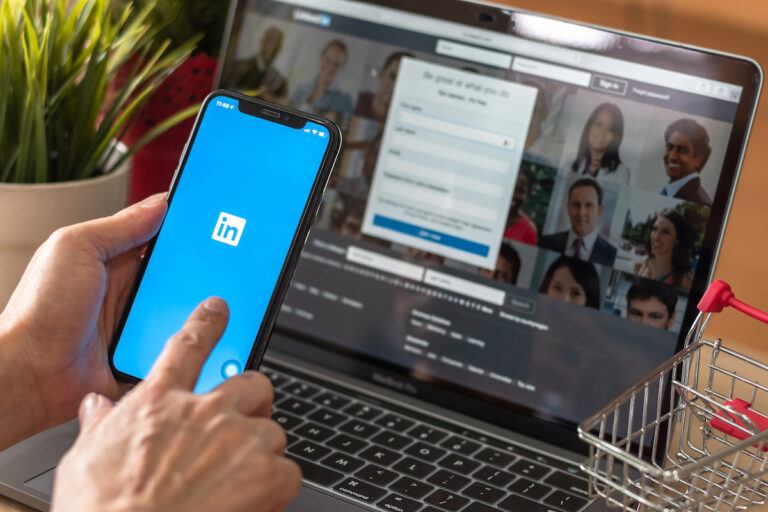What prevents senior leaders from posting on LinkedIn? Lorraine Emmett, Managing Director of B2B PR agency EC-PR provides some insight.
I’d wager it’s one of three things; a lack of time, feeling self-conscious and worrying people will think they’re looking for a new job.
And yet, LinkedIn is a powerful tool for senior leaders to foster trust and engagement with peers, prospects, and  customers. It has moved far beyond its first iteration in the early noughties when it was simply a tool for recruitment. But building an executive profile, or personal brand, is not something to be taken lightly. It requires consistency, authenticity, and a flair for standing out—all of which take skill and effort.
customers. It has moved far beyond its first iteration in the early noughties when it was simply a tool for recruitment. But building an executive profile, or personal brand, is not something to be taken lightly. It requires consistency, authenticity, and a flair for standing out—all of which take skill and effort.
In this article, Lorraine Emmett, Managing Director and founder of tech PR & communications agency, EC-PR, explores the essential ingredients for crafting a compelling and unique personal brand on LinkedIn that builds trust, distinction, and attracts prospects and customers.
Compel and repel
Personal branding is the process of systematically and thoughtfully shaping and managing your own professional identity. It’s about showcasing your unique personality, expertise and values to create a distinctive image and reputation in your industry.
Senior executives often underestimate the importance of personal branding and may be concerned about appearing boastful or egotistical by elevating themselves on LinkedIn. But by developing and maintaining a specific profile there is powerful value for both the individual and the business.
A personal brand should compel and repel in equal measures. You want to attract, inspire, and nurture stakeholders, investors, and supply chain partners who share your vision and values.
But you also want to repel those who distract from the ambition for your business.
That’s not to say you want to create a network of Stepford Wives or Yes People, not at all; you want to encourage healthy debate and discourse in your communication. Challenge makes us stronger and wiser – it helps us shape and refine our beliefs but it needs to be constructive and emotionally intelligent.
Building a legacy
Sharing insight and wisdom from your career journey can provide valuable insights for emerging leaders to learn from while showcasing your expertise and values. Your personal brand should inspire your team and industry peers. It sets a standard of excellence and motivates others to follow your lead. In this way, your personal brand not only enhances your leadership image but in times of crisis, a leader with a trustworthy reputation is in a far stronger position from the get-go.
Wielding Influence
A personal brand can influence how people perceive your entire company. A business with a well-loved, celebrated, and familiar leader will always have the advantage over an unfamiliar face. A strong and positive personal brand can bolster your company’s reputation, attracting talent as well as investors – think Simon Sinek, Steve Bartlett, Andy Yeoman, and Lea Turner to get an idea of the power of personal brands and its impact on business growth.
The halo effect is also significant as C-Suite executives with strong personal brands are often seen as thought leaders in their respective fields. This can lead to valuable speaking engagements, media opportunities, and industry recognition – further driving reach and influence.
Passion is also critical. If you advocate on industry trends, causes, or initiatives you’re passionate about, you will not only amplify your impact on important issues for your industry, but it will also position you as someone to look up to. This passion equips you with a commercial edge. Your personal brand can drive business growth by attracting customers and investors who resonate with your values and vision. By sharing who you are, what you have achieved in business, and your personal values, you can also attract and accelerate talent acquisition, helping with recruitment and retention efforts.
Why do leaders avoid creating a personal brand on LinkedIn?
Too many senior business leaders are unaware of the business value creating a strong personal brand delivers. Otherwise, they would prioritise it, making time for posting, learning, and becoming active.
As well as this, many leaders are concerned that they may appear foolish or appear egotistical, when actually a personal brand is as much about them as it is about the business they are helping to build.
Personally, through building my own personal brand on LinkedIn over the last year, I have recruited talent, cultivated supplier relationships, and been rewarded with 25% of our business leads coming through the channel. It’s certainly not to be sniffed at!
Authenticity is key
When building a personal brand on LinkedIn there are some common pitfalls to avoid. It’s something we help many senior leaders work through as part of our Catalyst personal branding service for the C-Suite.
The first and most important pitfall to avoid is being fake – authenticity is key. The language, subject matter, and the photos of you on your account need to reflect who you are, your expertise and your experience. This can even come down to the frequency of your posts which can be a particular challenge if someone is assisting or ghost-writing for you. Ghost-writing is commonplace because very few leaders have time to write their own posts. But you do still need to put skin in the game! You need to spend time with the professionals working with you in order for them to create authentic content. Authentic content uses your language, your cadence, and your flaws! Don’t try to create a persona that doesn’t align with your identity in real life. The people who know you will see through it, and those who gravitate to you won’t align with who you are, rendering the whole exercise somewhat pointless. This means you need to ensure your messaging and actions in real life align with your personal brand because inconsistencies can erode trust.
You also need to ensure your content doesn’t come across as simply self-promotion. You need to add value, seek to guide, influence and persuade. Acting as a mentor will reap huge rewards. You also need to avoid simply broadcasting. LinkedIn is a social network for a reason. It means you need to engage with and support your network by responding to comments on your posts but also commenting on theirs. You wouldn’t turn up to a conference, shout at the room, and then run away. It’s similar on LinkedIn, view it as a networking conference where you are one of the key speakers.
And don’t be afraid of feedback. You have two ears and one mouth for a reason. Listen to feedback and act on it. This is also true if you employ an agency or person to work with you on building your profile. You need people who are open to feedback, so you (and they) can adapt your personal brand as appropriate. If you put your head in the sand and ignore criticism, then it will only lead to stagnation and reduced engagement, reach and influence.
Finally, don’t assume your personal brand starts and finishes with LinkedIn. It encompasses so much more – from building your thought leadership contributions in key sector press, to attending industry events, speaking at conferences, and building relationships with people in person. Your personal brand is as much about who you are on LinkedIn as who you are in real life.

